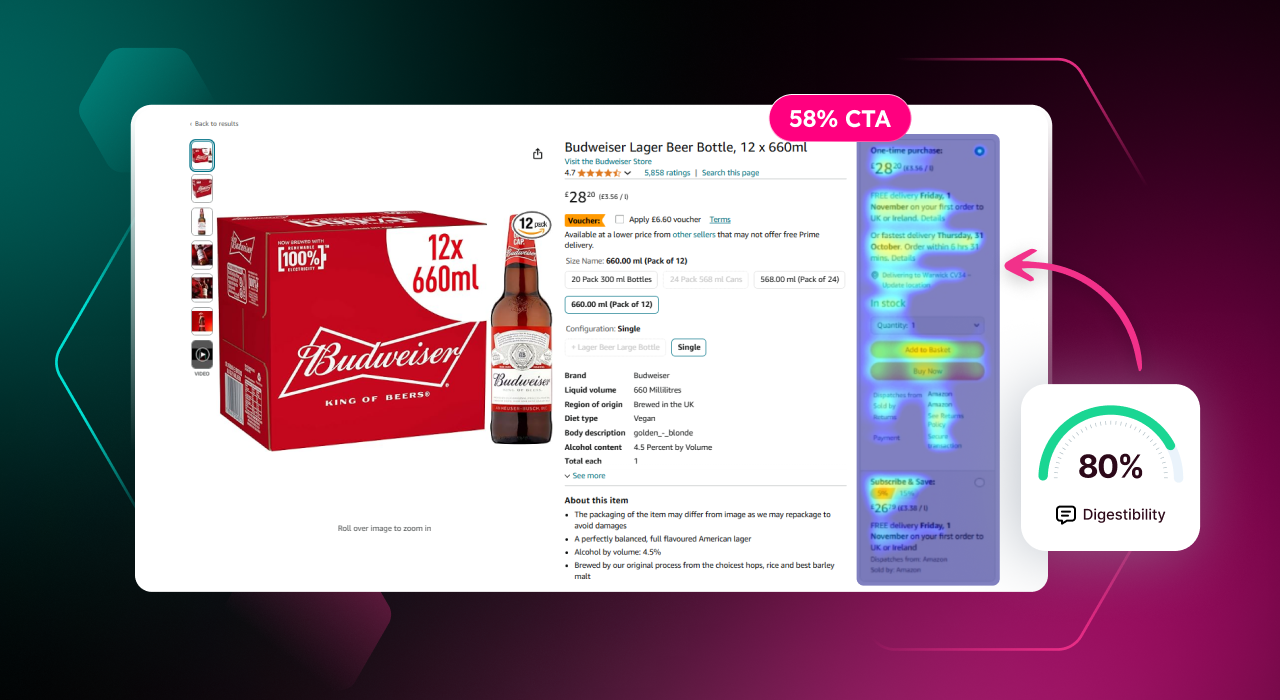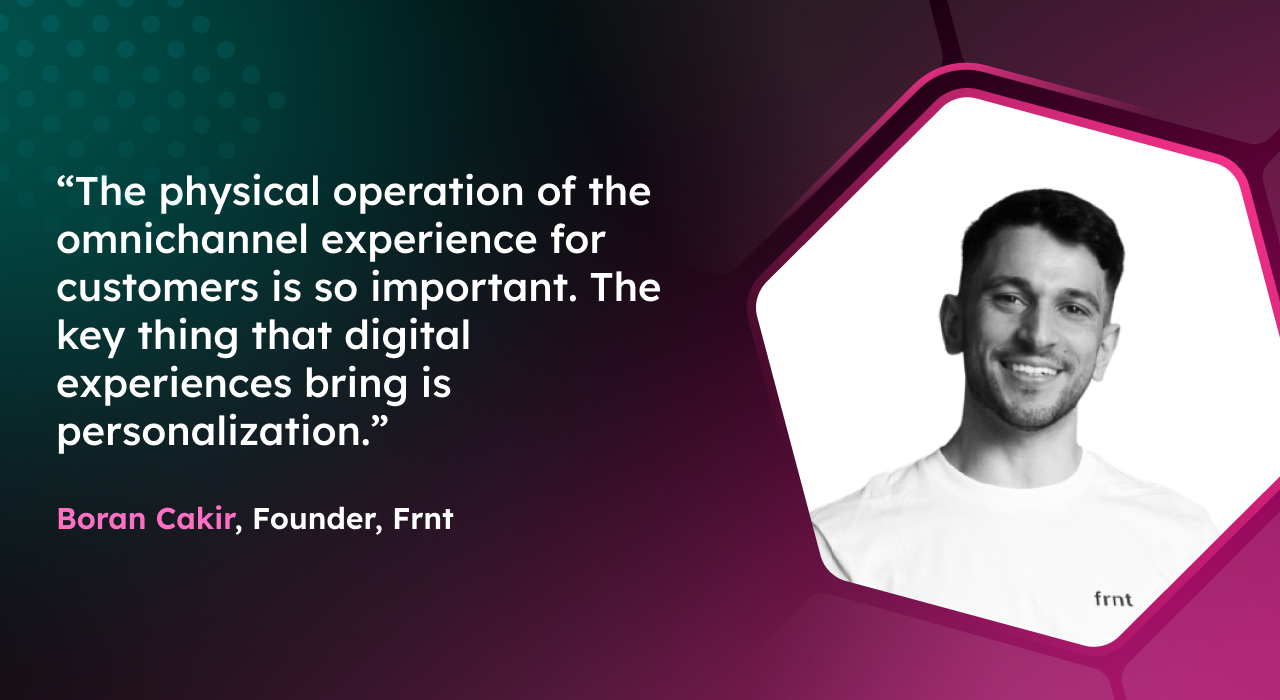Turning visitors into customers is the key to growth and success in e-commerce. Every click, scroll, and interaction on a website holds the potential to turn visitors into customers. This is where AI steps in. It offers a powerful way to increase conversions through predictive attention insights. Studies show that businesses using AI can increase conversion rates by as much as 20%. For example, Amazon uses its AI-powered recommendations engine to make personalized suggestions that drive 35% of its annual sales.
AI-powered predictive attention insights help companies understand user behavior. By analyzing vast amounts of data, these insights help businesses tailor their marketing strategies to ensure their customers receive personalized experiences.
This way, companies can improve customer engagement by highlighting the right elements at the right time. As a result, businesses can create more engaging digital environments that encourage users to take action.
The Challenges of E-Commerce Conversion Optimization
E-commerce conversion optimization is the process of improving your website for a better conversion rate by making small improvements like changing font or color. It also means improving your website to increase the percentage of visitors who take the desired action. This action can be making a purchase, signing up for a newsletter, or filling out a contact form.
For e-commerce, conversion rates are important as they directly impact the revenue and growth of a business. However, many businesses struggle with their conversion optimization. Some of the most common roadblocks include:
- Poor User Engagement: If visitors find a website difficult to navigate or the site fails to capture their interest, they are likely to leave without taking action.
- Unclear Calls to Action (CTAs): Customers may not know what steps to take next if CTAs are vague or placed in the wrong places. This confusion can lead to lost opportunities.
- Lack of Personalized Experiences: Customers today expect tailored experiences. The lack of personalized experiences can prevent customers from feeling connected to the brand, leading to missed sales opportunities.
So, how can you improve conversion rates and tackle these challenges? AI-powered insights can help businesses improve conversion and overcome these challenges. AI can analyze user behavior and offer businesses valuable data that informs decisions. Stats show that using behavioral data for targeted ads and personalized content can increase conversion rates by 10%.

This helps companies create targeted marketing and enhance their overall shopping experience. With AI, businesses can make data-driven choices that lead to better conversion rates and greater success in e-commerce.
How AI Provides Predictive Attention Insights?
Predictive attention insights are tools that help businesses understand where on their webpage users are most likely to pay attention. These tools also analyze how users interact with different elements on your webpage, such as images, text, or buttons. By predicting the most engaging areas on your website, these insights help businesses optimize their layout to make more visitors take action.
AI in User Experience Design
AI plays a key role in improving user experience by analyzing how users perceive your website. It looks at user behavior patterns, such as mouse movements or clicks. With these insights, businesses can adjust their website designs to match user expectations. This allows for more strategic placement of important content. This can also help companies align their web design with how users naturally navigate a site for a more engaging experience that encourages conversions.
Optimizing Visual Hierarchy
Predictive AI insights also help designers create a visual hierarchy that directs user attention to important elements like:
- Calls-to-Action (CTAs): Ensure that buttons and links driving conversions are prominently displayed and stand out, especially on the homepage.
- Product Images: Present products in a visually engaging way that instantly captures users' attention.
- Key Information: Place key details like pricing, benefits, or promotions where users will most likely notice them.
The Role of AI in E-Commerce Conversion Optimization
AI is transforming how e-commerce businesses approach conversion optimization. It helps companies fine-tune their user experience at every step using advanced data analytics and predictive modeling.
Personalization Digital Customer Engagement
Personalization is no longer just a perk. It’s a driving force behind conversions. In fact, 76% of consumers say they’re more likely to purchase from brands that offer personalized experiences. AI makes this possible by analyzing user data in real time to dynamically tailor website elements to individual preferences.
AI ensures each shopper’s experience is more engaging and relevant, ultimately boosting conversion rates. From personalized product recommendations based on browsing history to content that adapts to user behavior, AI helps boost conversion rates.
A/B Testing with AI
A/B testing is a common method to determine which website design or content works best for conversion. 60% of businesses report an increase in conversion rates after implementing A/B testing. AI can automate A/B testing and speed up the process. Instead of manually testing different website variations, AI can:
- Analyzes results quickly to see which design or content works best
- Continuously optimizes based on user preferences. This helps marketers make data-driven decisions that improve conversion rates faster.
Improving Load Time and UX
Another important role of AI is improving load times and overall user experience (UX). Slow-loading pages can frustrate users and lead to abandoned carts. AI tools can detect issues with slow page loading by identifying friction points in the user experience when they navigate a site. They can also recommend optimization strategies such as reducing image sizes or streamlining code that may help enhance performance.
Benefits of Using AI to Boost Conversion Rates
AI predictive insights offer numerous benefits for businesses who want to boost their conversion rate. These include:
- Higher Conversion Rates Through Personalization
AI makes creating personalized experiences for each visitor easier. This leads to better user engagement and higher conversion rates. By analyzing user behavior, AI can show relevant products, content, and offers that match the individual’s interests. This personalized approach keeps visitors engaged and increases the likelihood of taking the desired action.

- Better Decision-Making
Predictive attention insights help businesses make smarter design decisions. Instead of relying on guesswork or trial-and-error, companies can use data-driven insights to understand what works best for their audience. This minimizes the time and resources spent on ineffective strategies. As a result, businesses can focus on optimizing elements that truly enhance user experience and boost performance.
- Optimized User Journeys
AI can also optimize the entire customer journey and help create a smooth experience from start to finish. It can analyze user behavior to identify potential distractions or drop-off points in the buying process. The AI will then guide the users seamlessly through each step, from browsing to checkout. This streamlined approach increases the chances of conversion, as customers won’t abandon their carts when the process is easy and intuitive.
Best Practices for Using AI in Conversion Optimization
AI can enhance conversion optimization to drive maximum sales for businesses. However, to ensure maximum impact, it is important to follow best practices. These include:
Strategic Placement of CTAs and Key Elements
To maximize the impact of AI in conversion optimization, businesses must strategically place key elements like CTAs. AI can predict where users are most likely to focus, and this can guide designers in positioning these elements more efficiently. This strategic placement will then capture user attention and drive conversions. To maximize conversions, you can:
- Use AI insights to place CTAs where they will receive the most attention.
- Position essential elements, such as product images or offers, in high-visibility areas. This will help guide users toward desired actions.
- Make sure your key elements are easy to find and interact with. This will reduce the chances of missed opportunities.
Continuous Testing and Iteration
Continuous testing and iteration are important for AI to drive long-term success in conversion optimization. It is important to continue testing and making adjustments to changing user behavior. AI can help optimize your website over time by supporting ongoing testing and updates:
- Regularly conduct A/B tests using AI to evaluate different designs, layouts, and content.
- Use AI-driven insights to identify what is working and what needs adjustment quickly.
- Continuously improve your site as user behaviors evolve to ensure it stays optimized for engagement and conversions.
Combining AI with Other Analytics Tools
Combining AI insights with other analytics tools is another way to optimize conversions using AI. For a complete picture of what drives conversions:
- Combine AI insights with analytics tools like Dragonfly AI. Dragonfly AI is a predictive analytics platform designed to improve the quality and effectiveness of visual content across various channels. Real-time data helps businesses understand how their creative assets capture consumer attention and drive engagement.
- AI can predict where attention will go, but other tools can show how users behave in real time and give a deeper understanding of their actions.
- Together, AI and analytics can help you address both predictive and real-time challenges. This can also help you improve conversion strategies from multiple angles.
Case Studies: How AI Boosted Conversion Rates
Numerous e-commerce companies have successfully used AI to enhance conversion rates through improved user experience design and predictive attention insights. Here are a few notable examples:
Case Study 1- North Face
North Face used AI-driven personalization and predictive analytics to offer tailored shopping experiences. The company introduced a voice-powered AI assistant that helped guide customers through product selections based on real-time weather data and user preferences. This level of personalized engagement led to a 60% increase in click-through rates.
Case Study 2 - Sephora
Sephora, a leader in beauty retail, used AI to revolutionize its online shopping experience. Through the AI-powered Visual Artist and virtual assistant, Sephora helped customers try products virtually and receive personalized recommendations based on their preferences and purchase history. The AI tracked user behavior and adapted recommendations in real time, leading to a 30% increase in user engagement and an 11% boost in conversions.
Boost Your Conversion Rates with Dragonfly!
Understanding how to improve conversion rates is the key to success in the competitive e-commerce space. AI has proven to be a powerful tool for improving conversion rates. By predicting user behavior and providing insights into how visitors interact with a website, AI allows businesses to optimize their designs and create personalized experiences. This improved digital customer engagement leads to higher conversion rates, making AI a valuable asset in the digital space.
With Dragonfly AI, you can predict where your customers' attention will be focused, ensuring that your creative content stands out in a crowded marketplace. Our predictive analytics platform empowers you to optimize visual content across all channels to drive engagement and boost conversion rates.
Don't let your creative efforts go unnoticed. Book a 15-minute demo today and discover how Dragonfly AI can help you make data-driven decisions that lead to increased revenue and improved performance.
